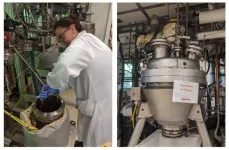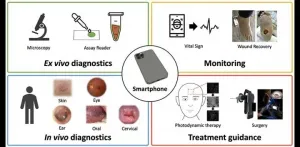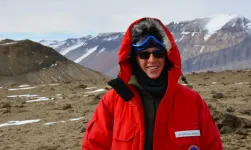(Press-News.org) LA JOLLA, CA--Some survivors of ebolavirus outbreaks make antibodies that can broadly neutralize these viruses--and now, scientists at Scripps Research have illuminated how these antibodies can disable the viruses so effectively. The insights may be helpful for developing effective therapies.
Ebolavirus is a family of often-deadly viruses that includes Ebola virus and many lesser-known viruses such as Bundibugyo virus, Sudan virus and Reston virus.
Structural biologists at Scripps Research used electron microscopy techniques to visualize a set of antibodies that target a key site on these viruses called the "glycan cap." Their research showed that the antibodies work against ebolaviruses using the same three mechanisms to prevent the virus from infecting host cells.
The research, published in Cell Reports, is a step toward the creation of an antibody-based treatment that will be useful against a broad range of ebolaviruses.
"We now understand the molecular basis for these antibodies' abilities to neutralize ebolviruses with broad reactivity against different viral species," says the study's first author Daniel Murin, PhD, a staff scientist in the laboratory of Andrew Ward, PhD.
Ward, a professor in the Department of Integrative Structural and Computational Biology at Scripps Research, says he hopes the work will contribute the development of a "cocktail" of therapeutic antibodies that can save lives by treating many forms of the Ebola virus.
"The goal is to provide doctors in Ebola-prone regions their best weapon yet against these deadly outbreaks," Ward says. "The insights we have gained through our structural studies of the virus show how this may be possible."
Ever-emergent Ebola
The first known ebolavirus, now called Zaire ebolavirus or simply Ebola virus, was identified in 1976, named for the site of an outbreak that year near the Ebola river in what was then Zaire and is now the Democratic Republic of Congo.
Other species have since been added to this family of viruses, including Sudan ebolavirus and Bundibugyo ebolavirus. Ebola viruses colonize African fruit bats, often cause disease in chimpanzees and other non-human primates, and trigger outbreaks in humans every few years, on average. Infected people develop a hemorrhagic syndrome that is fatal in roughly half of untreated cases.
Vaccines against Ebola have been developed recently but have not yet been widely used. And although antibody-based treatments also have been developed, none has been shown effective against a broad range of ebolavirus species.
Nevertheless, studies in recent years have shown that some survivors of Ebola infections carry antibodies that, in lab-dish tests, can neutralize multiple ebolavirus species. A surprisingly high proportion of these broadly neutralizing antibodies target the glycan cap, a sugar-slathered site on a stalk-like protein--called the glycoprotein--that enables Ebola viruses to enter host cells.
In the new study, Murin and Ward, along with their colleagues in the James Crowe Lab at Vanderbilt University where the antibodies were isolated, used electron microscopy to analyze a set of glycan cap-targeting antibodies from survivors of various ebolaviruses. Their aim was to understand better how these antibodies target the virus so effectively.
Three ways to defeat the virus
Their analysis suggested that the most broadly effective of these glycan cap-targeting antibodies hit the same vulnerable site on the glycan cap, allowing them to thwart viral infectivity in three ways.
First, the antibody displaces a long viral structure near the glycan cap in a way that destabilizes the entire viral glycoprotein structure, sometimes causing it to fall apart.
Second, the glycan cap antibody--when it binds to its target site--can block a key event in the infection process, in which an enzyme called a cathepsin cleaves off the glycan cap. Blocking this cleavage event blocks the glycoprotein's ability to enter host cells.
Finally, the glycan cap antibody, by displacing the loose structure near the glycan cap, enables another type of neutralizing antibody to bind to a separate vulnerable site on the virus. Thus, a glycan cap antibody can "synergize" with another antibody to hit the virus significantly harder than either antibody does alone.
The scientists also determined the key genetic elements that allow glycan-cap antibodies to thwart ebolaviruses in these three ways.
Now that they have illuminated how these broadly neutralizing antibodies work, Ward, Murin and colleagues are testing them as parts of a next-generation antibody cocktail that they hope will be able to treat the Zaire, Sudan and Bundibugyo ebolaviruses.
INFORMATION:
The study, "Convergence of a common solution for broad ebolavirus neutralization by glycan cap-directed human antibodies" was authored by Daniel Murin, Pavlo Gilchuk, Philipp Ilinykh, Kai Huang, Natalia Kuzmina, Xiaoli Shen, Jessica Bruhn, Aubrey Bryan, Edgar Davidson, Benjamin Doranz, Lauren Williamson, Jeffrey Copps, Tanwee Alkutkar, Andrew Flyak, Alexander Bukreyev, James Crowe, and Andrew Ward
The research was supported by the National Institutes of Health (U19 AI109762, U19 AI142785)
MINNEAPOLIS/ST.PAUL (04/15/2021) -- New research from the University of Minnesota Medical School found mutations in a novel gene that may help identify patients with a specific form of muscular dystrophy.
The laboratory of Peter B. Kang, MD, the new director of the Paul & Sheila Wellstone Muscular Dystrophy Center at the U of M Medical School, studies the genetics and disease mechanisms of muscular dystrophy. It uses cutting-edge genomic methods to discover disease-causing mutations in patients who cannot find answers via clinical genetic test facilities.
The Kang laboratory ...
Reliance on petroleum fuels and raging wildfires: Two separate, large-scale challenges that could be addressed by one scientific breakthrough.
Teams from Lawrence Berkeley National Laboratory (Berkeley Lab) and Sandia National Laboratories have collaborated to develop a streamlined and efficient process for converting woody plant matter like forest overgrowth and agricultural waste - material that is currently burned either intentionally or unintentionally - into liquid biofuel. Their research was published recently in the journal ACS Sustainable Chemistry & Engineering.
"According to a recent report, by 2050 there will ...
DURHAM, N.C. - Researchers at Duke University have developed a method that uses machine learning, satellite imagery and weather data to autonomously find hotspots of heavy air pollution, city block by city block.
The technique could be a boon for finding and mitigating sources of hazardous aerosols, studying the effects of air pollution on human health, and making better informed, socially just public policy decisions.
"Before now, researchers trying to measure the distribution of air pollutants throughout a city would either try to use the limited number of existing monitors or drive sensors around a city in vehicles," said Mike ...
A team of scientists used a telescope on the International Space Station to measure the size of PSR J0740+6620 (J0740, for short), the most massive known neutron star. NASA's Neutron star Interior Composition Explorer (NICER) has captured unprecedented detail from this stellar remnant to learn more about matter in its core, which is on the threshold of collapsing into a black hole.
The NICER team will introduce their groundbreaking findings at a press conference during the 2021 APS April Meeting. NASA astronaut Christina Koch will join them to talk about how researchers use the space station as a science platform.
From pencils to pulsars
"Matter makes up everything we can see in the universe, from pencils ...
Researchers from Skoltech and a major European bank have developed a neural network that outperforms existing state-of-the art solutions in using transactional banking data for customer credit scoring. The research was published in the proceedings of the 2020 IEEE International Conference on Data Mining (ICDM).
Machine learning algorithms are already extensively used in risk management, helping banks assess clients and their finances. "A modern human, in particular a bank client, continually leaves traces in the digital world. For instance, the client may add information about transferring money to another person in a payment system. Therefore, every person obtains a large number of connections that can be represented as a directed graph. Such a graph gives an additional ...
A new study by Texas A&M University researchers published in END ...
Smartphones get smarter every day. These "Swiss Army knives" of mobile computing become even more useful with specialized attachments and applications to improve healthcare. Based on inherent capabilities like built-in cameras, touchscreens, and 3D sensing, as well wearable peripheral devices, custom interfaces for smartphones can yield portable, user-friendly biomedical imaging systems to guide and facilitate diagnosis and treatment in point-of-care settings.
What are the most effective ways to leverage and augment smartphone capabilities? Helpful guidelines are provided in a critical review of emerging smartphone-based imaging systems END ...
An imaging agent allows scientists to better visualize Enterobacterales infections in patients, helping to address pathogens that can be life-threatening and frequently resist antibiotics. The agent was safe in 26 patients and differentiated infections from either sterile inflammation or COVID-19-linked pneumonia in hamsters. Enterobacterales is the largest group of disease-causing bacteria in humans, and includes common pathogens such as Escherichia coli, Salmonella, and Klebsiella pneumoniae. These species have become increasingly resistant to common antibiotics, which has led the Centers for Disease Control to label some drug-resistant strains as urgent threats to human health. However, scientists still lack tools that can rapidly ...
New research from the Florida State University College of Medicine has found that the personality trait neuroticism is consistently associated with a higher risk of developing the brain disorder Parkinson's disease.
The research by Professor of Geriatrics Antonio Terracciano and team, published in Movement Disorders, found that adults in the study who scored in the top quartile of neuroticism had more than 80% greater risk of Parkinson's, compared to those who scored lower on neuroticism.
"Some clinicians think that the anxiety and depression is just the result of Parkinson's," Terracciano said. "However, our findings suggest that some emotional vulnerability is present early in life, ...
AMHERST, Mass. - Last month saw the average concentration of atmospheric carbon dioxide (CO2) climb to almost 418 parts-per-million, a level not seen on Earth for millions of years. In order to get a sense of what our future may hold, scientists have been looking to the deep past. Now, new research from the University of Massachusetts Amherst, which combines climate, ice sheet and vegetation model simulations with a suite of different climatic and geologic scenarios, opens the clearest window yet into the deep history of the Antarctic ice sheet and what our planetary future might hold.
The Antarctic ice sheet has attracted the particular interest of the scientific community because it is "a lynchpin in the earth's climate system, affecting everything from ...




